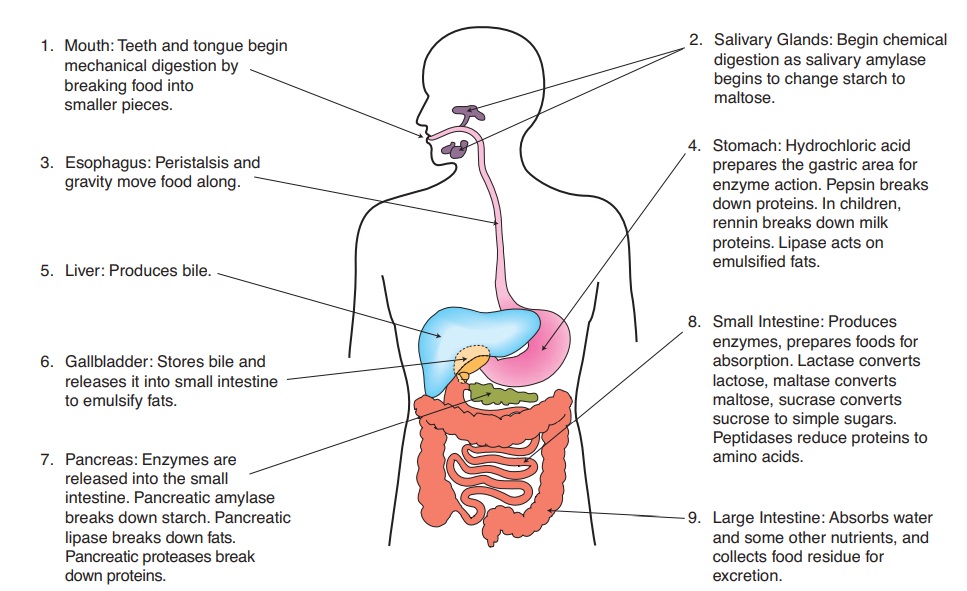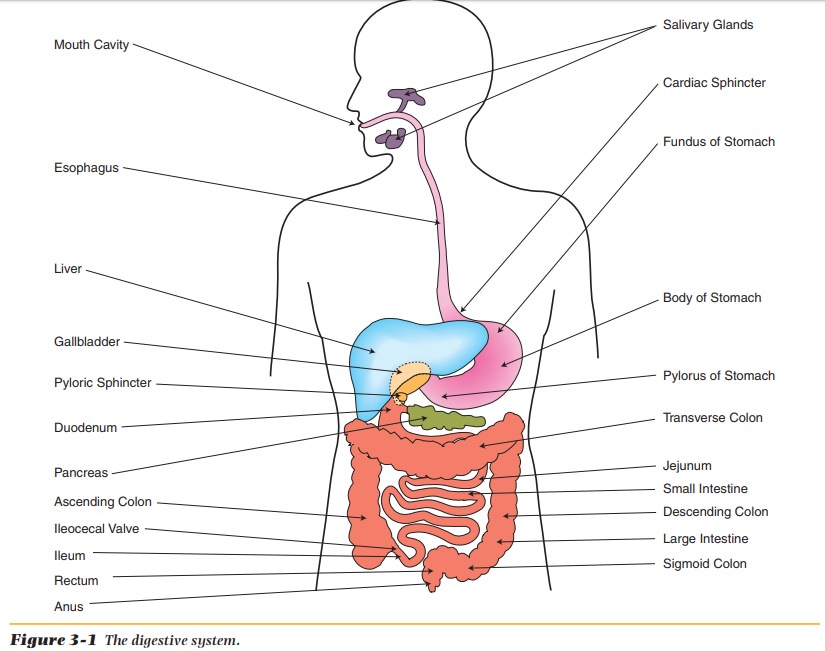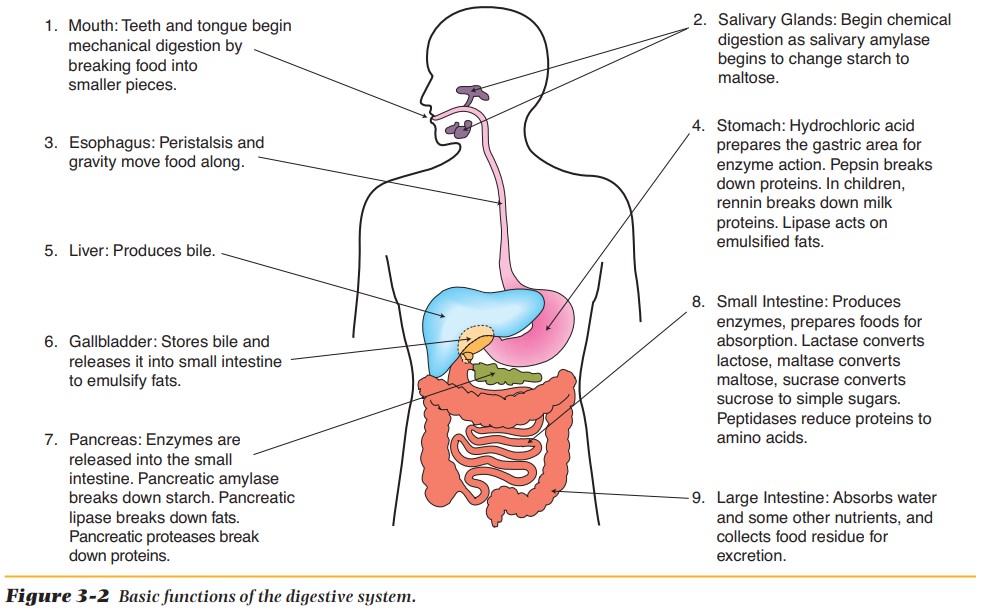Chapter: Nutrition and Diet Therapy: Digestion, Absorption, and Metabolism
Digestion

DIGESTION
Digestion is the process whereby
food is broken down into smaller parts,chemically changed, and moved through
the gastrointestinal system. The gas-trointestinal (GI)
tract consists of the body structures that participate indigestion.
Digestion begins in the mouth and ends at the anus. Along the entire GI tract
secretions of mucus lubricate and protect the mucosal tissues. As the process
of digestion is discussed, refer to Figure 3-1 and note the locations of the
structures that perform the functions of digestion.

Digestion occurs
through two types of action—mechanical and chemi-cal. During mechanical digestion, food is broken into
smaller pieces by the teeth. It is then moved along the gastrointestinal tract
through the esophagus, stomach, and intestines. This movement is caused by a
rhythmic contraction of the muscular walls of the tract called peristalsis. Mechanical digestion
helps to prepare food for chemical digestion by breaking it into smaller
pieces. Several small pieces collectively have more surface area than fewer
large ones and thus are more readily broken down by digestive juices.
During chemical digestion, the composition of
carbohydrates, pro-teins, and fats is changed. Chemical changes occur through
the addition of water and the resulting splitting, or breaking down, of the
food molecules. This process is called hydrolysis. Food is broken down
into nutrients that the tissues can absorb and use. Hydrolysis also involves
digestive enzymes that act on food
substances, causing them to break down into simple compounds. An enzyme can
also act as a catalyst, which speeds up the
chemical reactions without itself being changed in the process. Digestive
enzymes are secreted by the mouth, stomach, pancreas, and small intestine
(Table 3-1). An enzyme is often named for the substance on which it acts. For
example, the enzyme sucrase acts on sucrose, the enzyme maltase acts on
maltose, and lactase acts on lactose.

Digestion in the Mouth
Digestion begins in the mouth, where the food is broken into smaller pieces by the teeth and mixed with saliva (Figure 3-2). At this point, each mouthful of food that is ready to be swallowed is called a bolus. Saliva is a secretion of the salivary glands that contains water, salts, and a digestive enzyme called salivary amylase (also called ptyalin), which acts on complex carbo-hydrates (starch). Food is normally held in the mouth for such a short time that only small amounts of carbohydrates are chemically changed there. The salivary glands also secrete a mucous material that lubricates and binds food particles to help in swallowing the bolus. The final chemical digestion of carbohydrates occurs in the small intestine.

The Esophagus
The esophagus is a 10-inch muscular
tube through which food travels from the mouth to the stomach. When swallowed,
the bolus of food is moved down the esophagus by peristalsis and gravity. At
the lower end of the esophagus, the cardiac sphincter opens to allow
passage of the bolus into the stomach. The cardiac sphincter prevents the
acidic content of the stomach from flowing back into the esophagus. When this
sphincter mal-functions, it causes acid reflux disease.
Digestion in the Stomach
The stomach consists
of an upper portion known as the fundus, a middle area known
as the body of the stomach, and the end nearest the small intestine called the pylorus. Food enters the
fundus and moves to the body of the stom-ach, where the muscles in the stomach
wall gradually knead the food, tear it, and mix it with gastric juices, and
with the intrinsic factor necessary for the absorption of vitamin B12,
before it can be propelled forward in slow, controlled movements. The food
becomes a semiliquid mass called chyme (pronounced “kime”).
When the chyme enters the pylorus, it causes distention and the re-lease of the
hormone gastrin, which increases the
release of gastric juices.Gastric juices are digestive
secretions of the stomach. They containhydrochloric acid, pepsin, and mucus.
Hydrochloric acid activates the enzyme pepsin, prepares protein molecules for
partial digestion by pepsin, destroys most bacteria in the food ingested, and
makes iron and calcium more soluble. As the hydrochloric acid is released, a
thick mucus is also secreted to protect the stomach from this harsh acid. In
children, there are two additional enzymes: rennin, which acts on milk protein
and casein, and gastric lipase, which breaks the butterfat molecules of milk
into smaller molecules.
In summary, the
functions of the stomach include the following:
• Temporary storage of food
• Mixing of food with gastric juices
• Regulation of a slow, controlled emptying of food into the
intestine
• Secretion of the intrinsic factor for vitamin B12
• Destruction of most bacteria inadvertently consumed
Digestion in the Small Intestine
Chyme moves through
the pyloric sphincter into the duodenum, the first sec-tion of
the small intestine. Chyme subsequently passes through the jejunum, the midsection of the
small intestine, and the ileum, the last section of
the small intestine.
When food reaches the
small intestine, the hormone secretin causes the pancreas
to release sodium bicarbonate to neutralize the acidity of the chyme. The
gallbladder is triggered by the hormone cholecystokinin
(CCK), which is pro-duced by intestinal mucosal glands when fat
enters, to release bile. Bile is produced in
the liver but stored in the gallbladder. Bile emulsifies fat after it is
secreted into the small intestine. This action enables the enzymes to digest
the fats more easily.
Chyme also triggers
the pancreas to secrete its juice into the small intes-tine. Pancreatic juice
contains the following enzymes:
• Trypsin, chymotrypsin, and carboxypeptidases split proteins
intosmaller substances. These are called pancreatic
proteases because they are protein-splitting enzymes produced by the
pancreas.
• Pancreatic amylaseconverts starches (polysaccharides)
to simplesugars.
• Pancreatic lipasereduces fats to fatty
acids and glycerol.
The small intestine
itself produces an intestinal juice that contains the enzymes lactase, maltase, and sucrase. These enzymes split
lactose, maltose, and sucrose, respectively, into simple sugars. The small
intestine also produces enzymes called peptidases that break down
proteins into amino acids.
The Large Intestine
The large intestine,
or colon, consists of the
cecum, colon, and rectum. The cecum is a blind pouchlike beginning of the colon
in the right lower quadrant of the abdomen. The appendix is a diverticulum that
extends off the cecum. Thececum is separated from the ileum by the ileocecal
valve and is considered to be the beginning of the large intestine (colon). Its
primary function is to absorb water and salts from undigested food. It has a
muscular wall that can knead the contents to enhance absorption. One of the end
products of fermentation in the cecum is volatile fatty acids. The major
volatile fatty acids are acetate, propionate, and butyrate. These are absorbed
from the large intestine and used as sources of energy. The digested food then
enters the ascending colon and moves through the transverse colon and on to the
descending colon, the sigmoid colon, the rectum, and, finally, the anal canal.
Related Topics